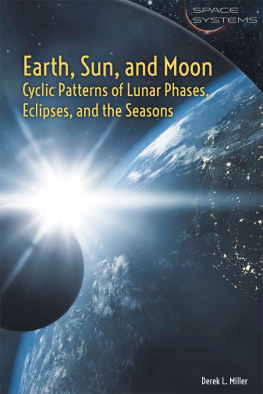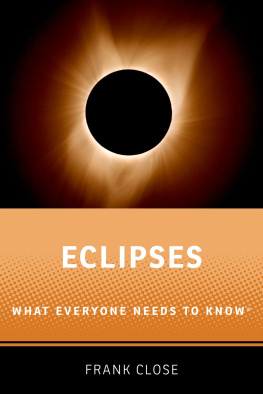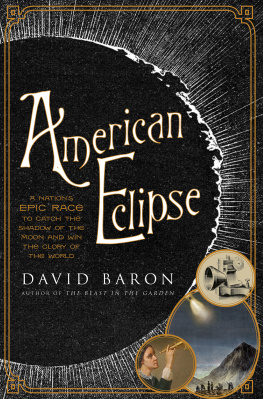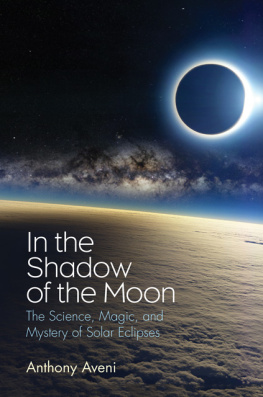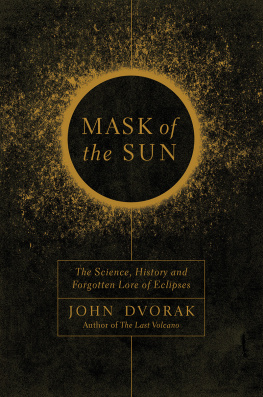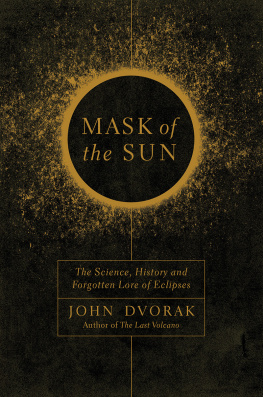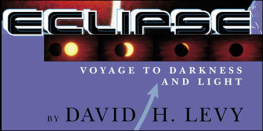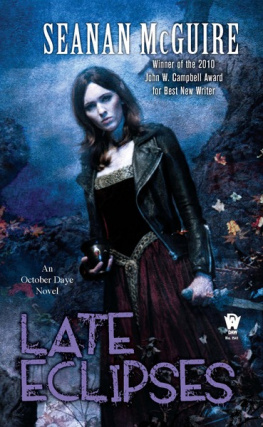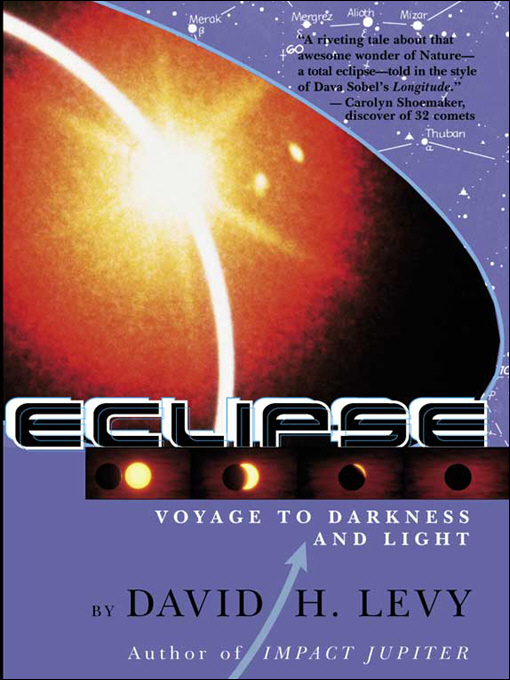ECLIPSE
VOYAGE TO DARKNESS
AND LIGHT
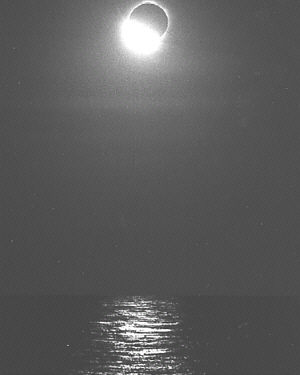
The eclipse enters totality with the appearance of the Suns corona, on the Atlantic Ocean 350 kilometers southeast of Halifax, Nova Scotia.Photo by Roy Bishop.
ECLIPSE
VOYAGE TO DARKNESS
AND LIGHT
DAVID H. LEVY

ibooks
new york
www.ibooksinc.com
DISTRIBUTED BY SIMON & SCHUSTER, INC.
Dedication
For Mom and Dad, who kindled my passion for eclipses as a child. Mom dashed across town to find a clear spot so that I could see my first eclipse in 1959; and my parents went to great lengths to make sure I saw my first total eclipse in 1963. For Wendee, who rekindled my passion for eclipses and who made the 1998 and 1999 eclipses cherished memories. And for Nannette, Mark, Summer, and all the eclipses in their future.
An Original Publication of ibooks, inc.
Pocket Books, a division of Simon & Schuster, Inc.
1230 Avenue of the Americas, New York, NY 10020
Visit us on the World Wide Web:
http://www.SimonSays.com
Copyright 2000 ibooks, inc.
Text copyright 2000 David H. Levy
Frontispiece: The August 11, 1999 solar eclipse enters totality, as seen from the Atlantic Ocean, 217 miles southeast of Halifax, Nova Scotia.
Photo: Roy Bishop
An ibooks, inc. Book
All rights reserved, including the right to reproduce this book or portions thereof in any form whatsoever.
Distributed by Simon & Schuster, Inc.
1230 Avenue of the Americas, New York, NY 10020
ibooks, inc.
24 West 25th Street
New York, NY 10010
The ibooks World Wide Web Site Address is:
http://www.ibooksinc.com
ISBN 1-58824-334-6
POCKET and colophon are registered trademarks of Simon & Schuster, Inc.
Cover design by Mike Rivilis
ACKNOWLEDGMENTS
In writing a book about a total eclipse of the Sun, I must first thank the Sun, the Moon, and the Earth for arranging themselves so precisely as to allow this event to take place at all. Unheard of and unseen anywhere else in the solar system, total solar eclipses, where Moon covers Sun and only the Sun, are unique to Earth and are quite probably rare throughout the Universe. We are extraordinarily lucky.
On human terms, I begin by thanking my wife Wendee, who revitalized my interest in eclipses. After the almost seven minutes of totality in Mexico in 1991, I thought I had seen every possible thing during a total eclipse, and I didnt care if I never saw another. But then came the annular eclipse of 1994. I observed with Clyde and Patsy Tombaugh in Las Cruces, New Mexico, and Wendee, then teaching physical education a few miles away, developed a program during which her young charges could watch the eclipse in safety. Afterwards, when she asked me what the difference between an annular eclipse and a total eclipse, I began to explain how, in the eclipse she saw, the Moon did not appear large enough to cover the Sun, and that in a total eclipse.... Suddenly I realized that the only way to answer her question was that we both had to see a total eclipse. We saw the eclipse of February 26, 1998, which to me was more amazing than any other, and we were hooked. Wendees family also had a great deal to contribute to the success of the 1999 voyage and the book that followed it. Her parents, Leonard and Annette, her sisters Gail and Joan-ellen, and her brother Sandy, all enjoyed this, their first eclipseexcept for Annette, who saw the 1925 eclipse from New York City.
On the Regal Empress, Ann Burgess of North Star Cruises did a superb job organizing the cruise and encouraging Regal Cruises to sail into the path as expertly as they did. Joe Rao and Sam Storch, two of the lecturers, provided important background. Captain Peter Schaab and his crew did a magnificent job building the experience that made this book a possibility. On the editorial side, my editor, Howard Zimmerman, and publisher Byron Preiss, came up with the idea for this book and helped it through to completion with enthusiasm and finesse. I also thank Art Boehm for his editorial suggestions.
Finally, thanks to Roy and Gertrude Bishop, and Leo Enright and Denise Sabatini, and Patsy Tombaugh. They shared this voyage at the same time they cemented our special bond of friendship.
CONTENTS
HOW ECLIPSES WORK
CHILDHOOD IMPRESSIONS OF
A DARKENED SUN
OF CYCLES AND FRIENDS
SUN, MOON, AND SURPRISE
THE POWER OF GRAVITY
THE ECLIPSE EXPERIENCE
THE VOYAGE BEGINS
SAILING CLOSER
HORSETAIL CIRRUS!
A VOYAGE TO DARKNESS
ALONE ON TWO WIDE, WIDE SEAS
ECLIPSE
A DIAMOND IN THE DARK
HERE COMES THE SUN!
HOW TO VIEW AN ECLIPSE SAFELY
FUTURE SOLAR ECLIPSES
FUTURE LUNAR ECLIPSES
A CANON OF ECLIPSES I HAVE SEEN
ECLIPSE SONG
PREFACE
Five billion years ago, a huge cloud of hydrogen gas swirled around in space. The cloud was thickest at its center, so dense that the gas glowed from the heat of its own gravity. At the outskirts of the cloud were other concentrations of gas and dust. As the cloud spun faster, its center grew hotter, until, at one single moment in time, it ignited in a burst of nuclear fusion to begin the life of our Sun.
With that ignition, the remaining gas and dust in the clouds outlying regions congealed to build at least nine planetary worlds, several dozen smaller worlds, and many comets and asteroids. At least two of these worlds were about the same size, one-fourth that of Earth. One moved around the Sun in a lazy elliptical path. It still does; we call it Mars. The other world flew round the Sun in an elongated orbit, alternately moving out into the fringes of the solar system and then tearing through the realm of the inner planets. Many times in that primordial history, this world came so close to Earth that its bulk would fill half the sky as it raced by, causing massive earthquakes and tidal disruptions before moving away. Finally, on one frightening day some four and a half billion years ago, this world came too close, sideswiping, moving away briefly, and then slamming into Earth.
The resulting explosion was so vast that it melted the entire crust of Earth. The other world broke apart, its pieces spinning out of control to collide with each other, and with Earth, again and again as a ring of debris, from both the Earth and the doomed world, formed high above Earth. Over the next year, the rings particles collided with one another, accreting to form at least one, and possibly two, new moons. One of them, too close, broke apart again, its pieces colliding with Earth in still more devastation. The other, farther away, formed the Moon we know and love.
At its creation the Moon was so close to Earth, a mere 10,000 miles away, that its immense tidal pull caused massive earthquakes and volcanic eruptions on a daily basis. As time passed, the Moon crept slowly farther from Earth, and still does, at the rate of about one and a half inches per year.
As it moved outward, the Moons gravity affected the tides of Earth less and less. As it took up less space in the sky, the Moon seemed to shrink, gradually becoming the same apparent size as the Sun, which is much bigger but also much farther away. And as the Moon continues to orbit the Earth, occasionally it passes in front of the Sun.



